#Albert hall museum
Explore tagged Tumblr posts
Text

Albert Hall Museum Jaipur, Rajasthan India.
After Jal Mahal, we decided to visit Albert hall Museum. It is located near Ajmeri gate, the oldest museum in Rajasthan built in 1876. we visited there at day but I ill suggest you to visit in nigh because building looks beautiful when it lightens up with yellow light.
#albert hall#albert hall museum#jaipur india#jaipur rajasthan#jaipur tour package#jaipur tourism#rajasthan#tourism#travel rajasthan#travel india#travel#travel photography#travelphotography#travel inspiration
2 notes
·
View notes
Text
Places To Visit In Jaipur | Know About 10 Famous Places In Jaipur.
Without visiting Jaipur, a vacation to India would be incomplete. Jaipur, affectionately known as “The Pink City,” is a regal paradise of culture and tradition, rich with architectural marvels. Its historical structures are blushing pink, earning it the nickname “The Pink City.” Also, it is an important stop on the well-known tourist route known as the “Golden Triangle” of India. Read more
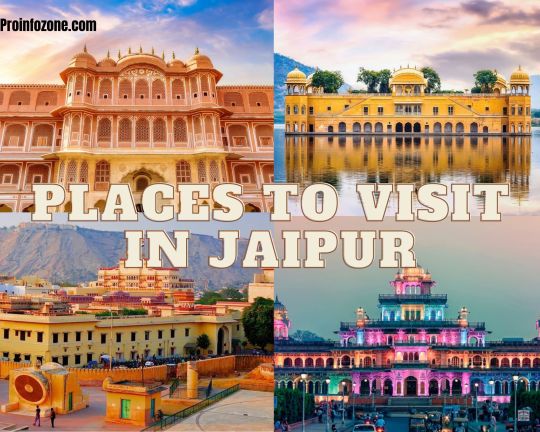
#places to visit in udaipur#india#traval#united states#nature#places to visit in jaipur at night#places to visit in rajasthan#Rajasthan#Hawa Mahal#Jantar Mantar#City Palace#Amber Fort#Jal Mahal#Jaigarh Fort#Birla Mandir#Nahargarh Fort#Panna Meena ka Kund#Albert Hall Museum
2 notes
·
View notes
Text
Jaipur Jodhpur Jaisalmer Tour Package
Rajasthan’s 3 most favourite cities Jaipur Jodhpur Jaisalmer invites you to explore its magnificence and unparalleled majesty with its Royal Palaces and Renovated Havelis. Rajasthan, often known as the “Cultural Capital of India,” is one of those places that should be experienced fully, and our trip package has been meticulously designed to help you accomplish that. Jaipur, Jodhpur, and Jaisalmer are three popular tourist destinations in Rajasthan, India. There are various tour packages available that cover all three cities. These packages typically include transportation, accommodation, meals, and sightseeing.
The Jaipur Jodhpur Jaisalmer tour package usually begins with a visit to Jaipur, the capital city of Rajasthan. Known as the "Pink City," Jaipur is famous for its forts, palaces, and colorful bazaars. Popular attractions in Jaipur include the Amber Fort, City Palace, Hawa Mahal, Jantar Mantar, and the Albert Hall Museum.
The second stop on the tour is Jodhpur, also known as the "Blue City" due to the blue-colored houses in the old town area. Jodhpur is home to the majestic Mehrangarh Fort, which offers stunning views of the city. Other popular attractions in Jodhpur include the Jaswant Thada, Umaid Bhawan Palace, and the bustling Sardar Market.
The final stop on the tour is Jaisalmer, a city located in the heart of the Thar Desert. Jaisalmer is known for its magnificent sandstone fort and havelis (old mansions). Visitors can also enjoy camel safaris, cultural performances, and shopping for local handicrafts at the bustling bazaars.
Overall, the Jaipur Jodhpur Jaisalmer tour package is a great way to explore some of the most popular tourist destinations in Rajasthan and experience the rich history and culture of the region.

#Jaipur#Jodhpur#Jaisalmer#Rajasthan#India#tour package#transportation#accommodation#meals#sightseeing#Pink City#Amber Fort#City Palace#Hawa Mahal#Jantar Mantar#Albert Hall Museum#Blue City#Mehrangarh Fort#Jaswant Thada
0 notes
Text
Best Jaipur Sight Seeing Packages
Jaipur, also known as the Pink City, is the capital of the Indian state of Rajasthan. It is famous for its rich history, stunning architecture as well as vibrant culture. There are many must-visit tourist destinations in Jaipur. These can explored with the help of various sightseeing packages available. Dhanvi tours offers the best Jaipur sight seeing packages.

#Jaipur#Pink city#Rajasthan#JaipurTour#Tours#destinations#trav#Hawa maha#Jantar mantar#Amer fort#Birla Temple#Jaigarh fort#Jal Mahal#Albert hall museum#tour packages
0 notes
Text
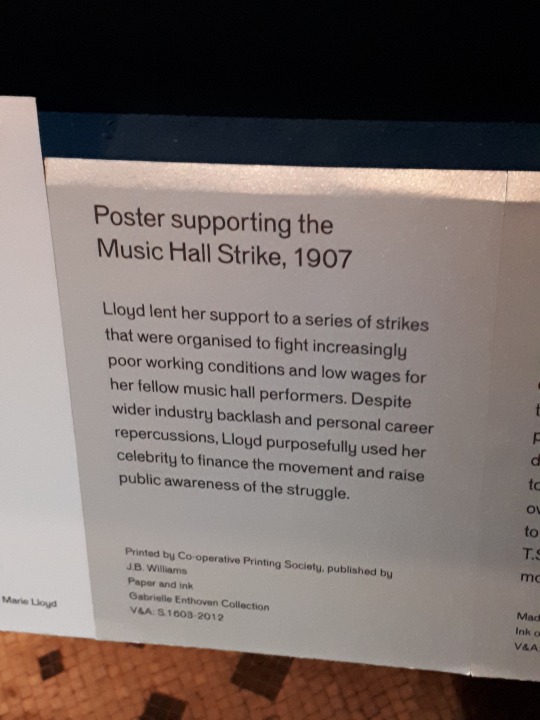
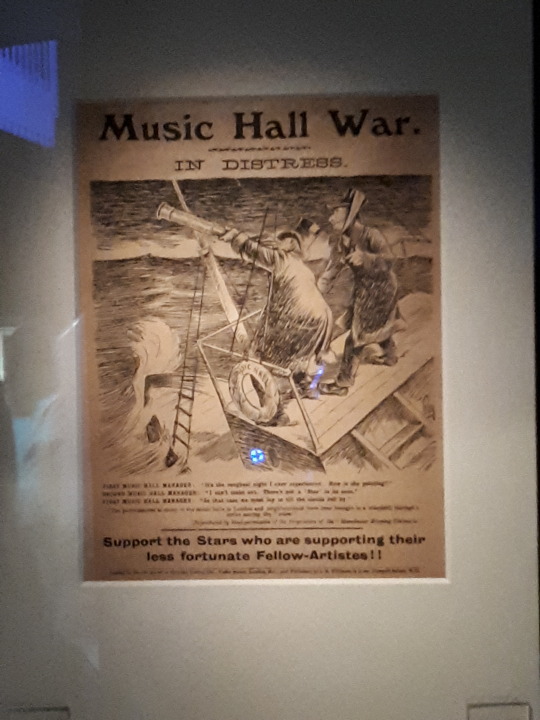
Spotted this fascinating bit of history at the DIVA exhibit at the Victoria and Albert Museum; the Music Hall War!!!
#Marie lloyd#Music hall war#DIVA#victoria and albert museum#Try to catch this exhibit if you're in london#It's on until april 2024!
12 notes
·
View notes
Text




At the Museum
34 notes
·
View notes
Text
Short Video Tour of the Albert Hall Museum at Jaipur, Rajasthan
Take a virtual stroll through the Albert Hall Museum in Jaipur, Rajasthan with this fascinating short video tour! #AlbertHallMuseum #Jaipur #VideoTour Watch now: https://www.youtube.com/watch?v=LZmQ45_xYS0
0 notes
Text

1 note
·
View note
Text
Manchester Vacation Travel Guide | Expedia
Manchester – A city whose history speaks to brave innovation. Check out the top spots in the city to explore and the cultural and … source
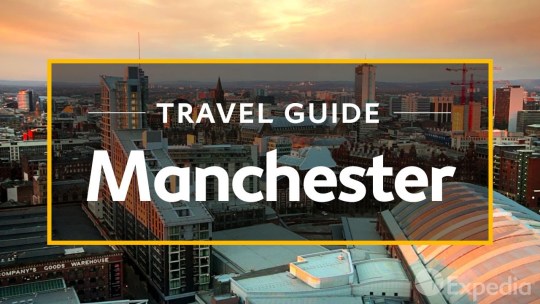
View On WordPress
#Albert Square#Arley Hall#best travel destinations in the world#Castlefield Roman Fort#Chetham&039;s Library#cvg#expedia#Imperial War Museum North#John Rylands Library#Manchester#Manchester Art Gallery#Manchester City#Manchester City Hall#Manchester Museum#Manchester United#MediaCityUK#Museum of Science and Industry#Old Trafford#People&039;s History Museum#Piccadilly Gardens#Piccadilly Square#St. Peter&039;s Square#Whitworth Art Gallery
0 notes
Text
Dracula cross-stitch sampler pattern
Since I've had time on vacation, I finished up a cross-stitch pattern I started a year ago in the first Dracula Daily round, based on the words Dracula uses to greet Jonathan Harker when he comes to the castle: "Welcome to my house. Come freely, go safely, and leave some of the happiness you bring".

I wanted a sampler for my front hall, but all the patterns I could find were very Hot Topic Goth. Nothing wrong with that, but my goth aesthetic is more "creepy thing found behind the wall in an old attic", and I wanted a pattern that my aunt wouldn't realize was anything out of the ordinary. I was looking around for inspiration and stumbled on an 1871 sampler by 12-year-old Jemima Clements in the Victoria & Albert Museum in London. It's a little bit early for Dracula but the aesthetic was spot on, so I spent a long time squinting at a zoom of the best download of it they had to copy the wolves and the letters, and then left it for almost a year because I got frustrated trying to figure out how to get a good-formatted pattern out.
When we came up on a year I transcended frustrated and went with the good-old fashioned grandma method and transferred my pixels to a spreadsheet. So on the off chance you want a creepy Dracula sampler for your front hall, I now have it in .pdf and a downloadable Google Sheet. The .pdf is formatted to print on legal paper, but it will be a bit small that way; you are welcome to fiddle with the spreadsheets to get it the size you want.
PDF of the pattern of the Dracula quote ^this will not work if your browser redirects to https because my webhost messed that up, but it should work if you force http
Google Drive link to a shareable/downloadable Sheets file
The pattern uses 7-10 different thread colors; I don't believe in locking in brand-name floss, so the pattern includes color description and it's up to you to find stuff in your stash that looks good together.
I could not come up with a decision on the border, so the options are:
Make all the flowers plain lavender
Use a variegated purple for the flowers
Pick 4-6 different shades of lavender/light purple and alternate them - this is most similar to Jemima's border
Use the "allium flower" pixel art pattern I coded into the pattern (recommended only if you recognized the allium flower pixel art pattern I used.)
#dracula daily#dracula#cross stitch#cross-stitch#sampler#embroidery#pattern#welcome to my house#come freely#go safely#and leave some of the happiness you bring#don't recommend putting this on the front door since the caveats on the welcome are pretty vague#wolves#the children of the night#not the music the original sampler meant#(probably but never underestimate the creepiness of twelve year old girls)#(I don't know why else you'd do howling wolves for a prayer about music)
1K notes
·
View notes
Note
Please tell me ya'll have seen Robin Williams' bit on piercings?
What them tongue rings do tho? 😏
Well I do eat my Cadbury creme egg from the inside out ;-)

#for those playing the home game this is called a Prince Albert#and I'm sure that was his last wish as he lay on his death bed:#Victoria I'm dying. I want you to name a hall... a museum... and a bolt through the cock after me...#That shall be Victoria's Secret! Go sell flimsy teddys now! Go!
30 notes
·
View notes
Photo
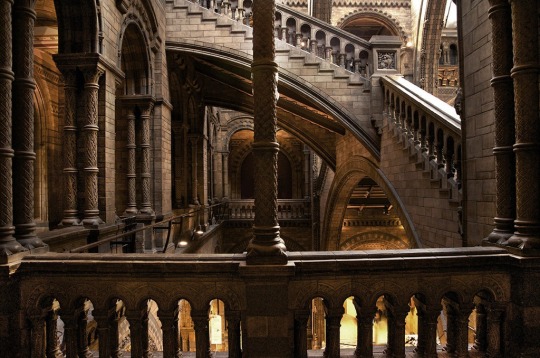
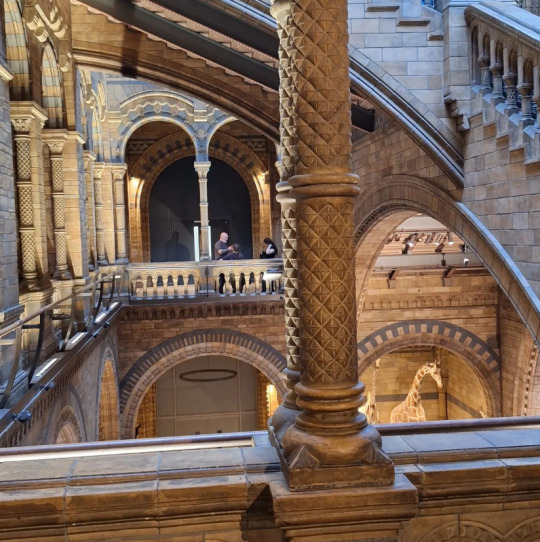
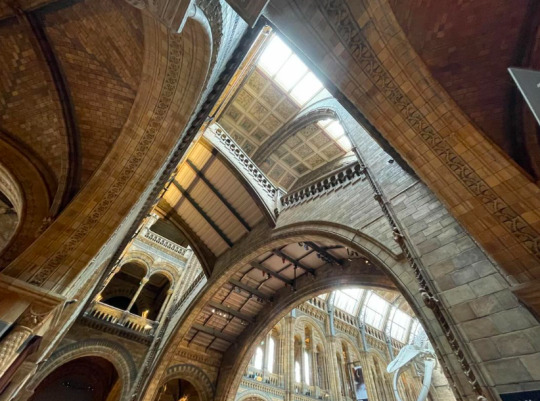
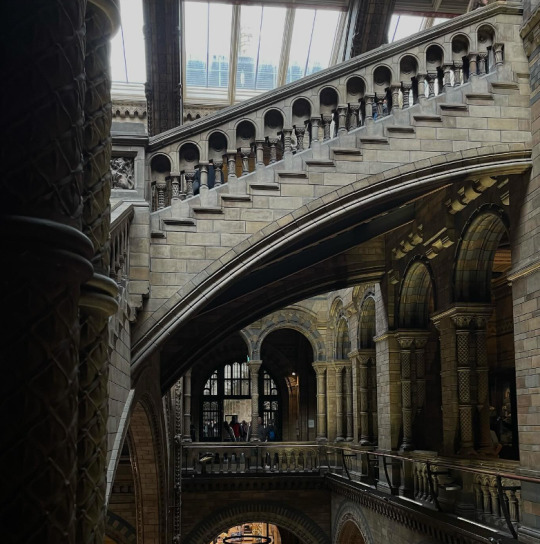
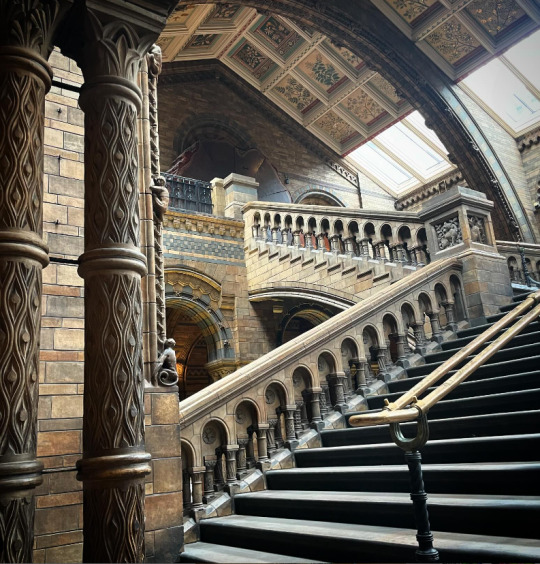


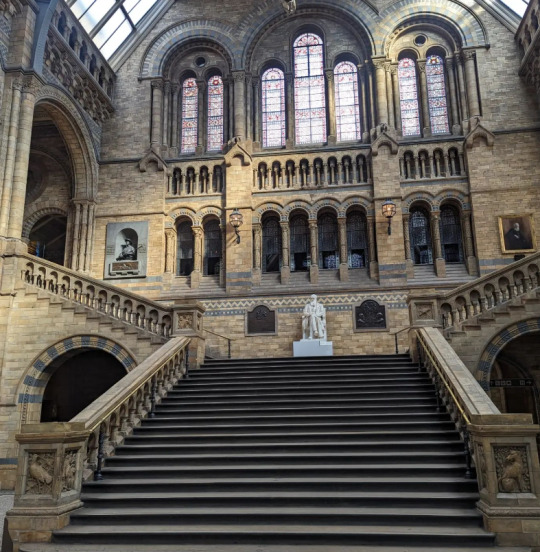
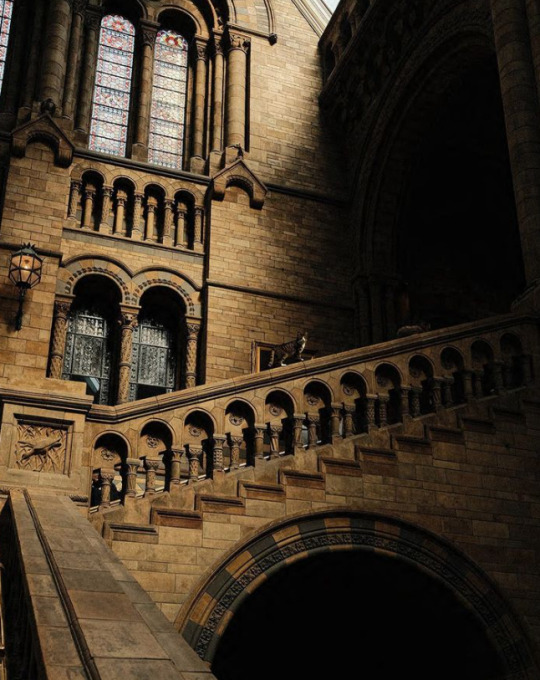
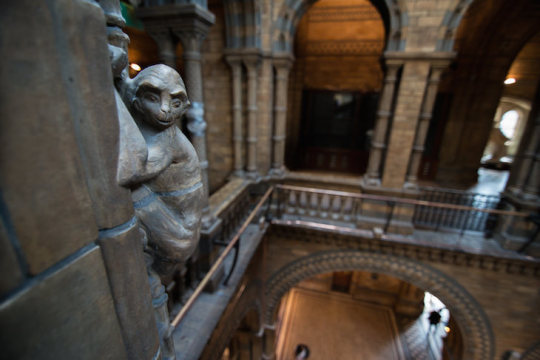

Natural History Museum - London
The Museum first opened its doors on 18 April 1881, but its origins stretch back to 1753 and the career of Sir Hans Sloane, a doctor and collector. Sloane travelled the world as a high society physician. He collected natural history specimens and cultural artefacts along the way. After his death in 1753, Parliament bought his extensive collection of more than 71,000 items, and then built the British Museum so these items could be displayed to the public. In 1856 Sir Richard Owen - the natural scientist who came up with the name for dinosaurs - left his role as curator of the Hunterian Museum and took charge of the British Museum’s natural history collection. Unhappy with the lack of space for its ever-growing collection of natural history specimens, Owen convinced the British Museum's board of trustees that a separate building was needed to house these national treasures. He drew-up a rough architectural plan in 1859 entitled 'Idea of a Museum of Natural History'. The plan was later referred to by architect Alfred Waterhouse in the design of the Natural History Museum. In 1864 Francis Fowke, the architect who designed the Royal Albert Hall and parts of the Victoria and Albert Museum, won a competition to design the Natural History Museum. However, when he unexpectedly died a year later, the relatively unknown Alfred Waterhouse - a Quaker architect from the north of England - took over and came up with a new plan for the Museum. Waterhouse used terracotta for the entire building as this material was more resistant to Victorian London's harsh climate. Construction began in 1873, and the result is one of Britain’s most striking examples of Romanesque architecture — considered a work of art in its own right and has become one of London's most iconic landmarks. Owen's foresight has allowed the Museum to display very large creatures such as whales, elephants and dinosaurs, including the beloved Diplodocus cast that was on display at the Museum for 100 years. He also demanded that the Museum be decorated with ornaments inspired by natural history. And he insisted that the specimens of extinct and living species kept apart at a time when Charles Darwin’s theory of evolution was revealing the links between them. Along with incorporating Owen’s ideas into his plans, Waterhouse also designed an incredible series of animal and plant ornaments, statues and relief carvings throughout the entire building – with extinct species in the east wing and living species in the west. Waterhouse sketched every one of these sculptures in great detail, even asking Museum professors to check the scientific accuracy of his drawings, before creating the fantastic decorations that complement the Museum’s exhibitions. While the building reflects Waterhouse’s characteristic architectural style, it is also a monument to Owen’s vision of what a museum should be. In the mid-nineteenth century, museums were expensive places visited only by the wealthy few, but Owen insisted the Natural History Museum should be free and be accessible to all. The Museum took nearly eight years to build, and moving the collections from the British Museum in Bloomsbury was a huge job. Relocating the zoological specimens, which included huge whale bones and taxidermy mammals, took 394 trips by horse and cart spread over 97 days. The Natural History Museum finally opened in 1881. The building’s decorative and Romanesque style by Waterhouse is reminiscent of medieval European abbeys, but it is also a monument to Owen’s vision of what a museum should be: the world’s largest and finest institution dedicated to natural history.
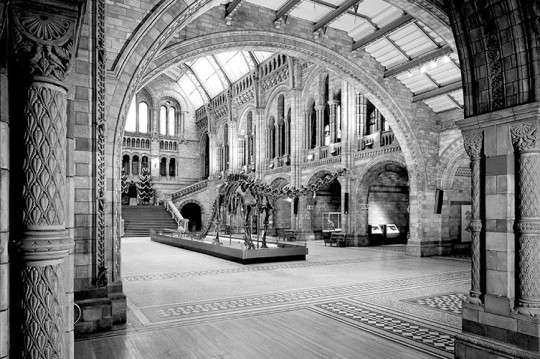
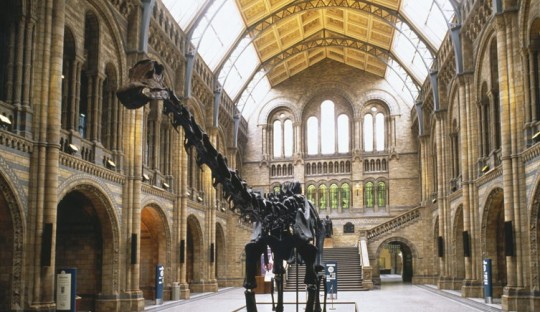
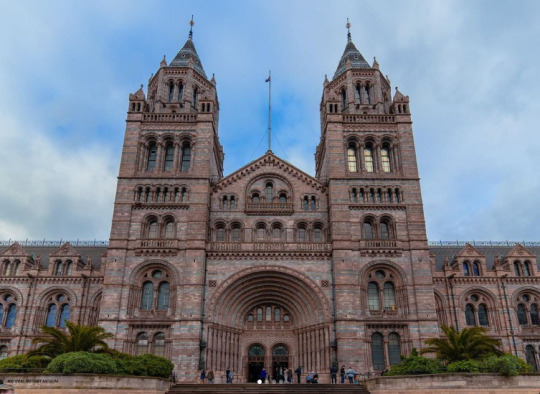
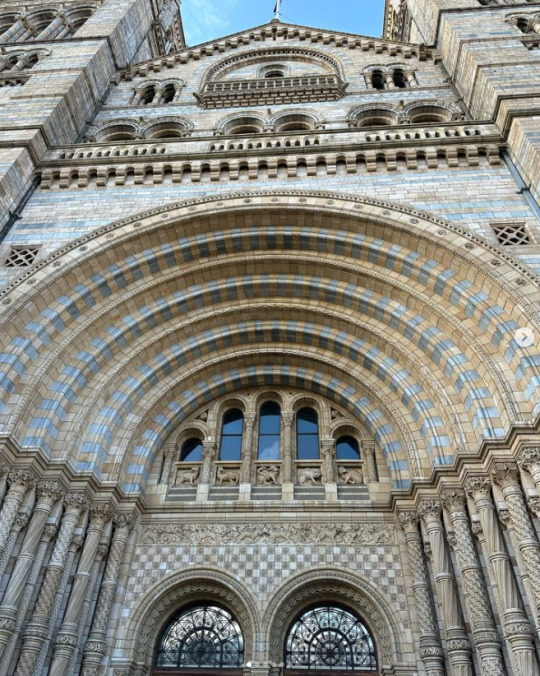
https://www.nhm.ac.uk/about-us/history-and-architecture.html
https://www.nhm.ac.uk/visit/virtual-museum.html
#other's artwork#architecture#Romanesque#Alfred Waterhouse#Sir Richard Owen#terra cotta#Natural History
66 notes
·
View notes
Text
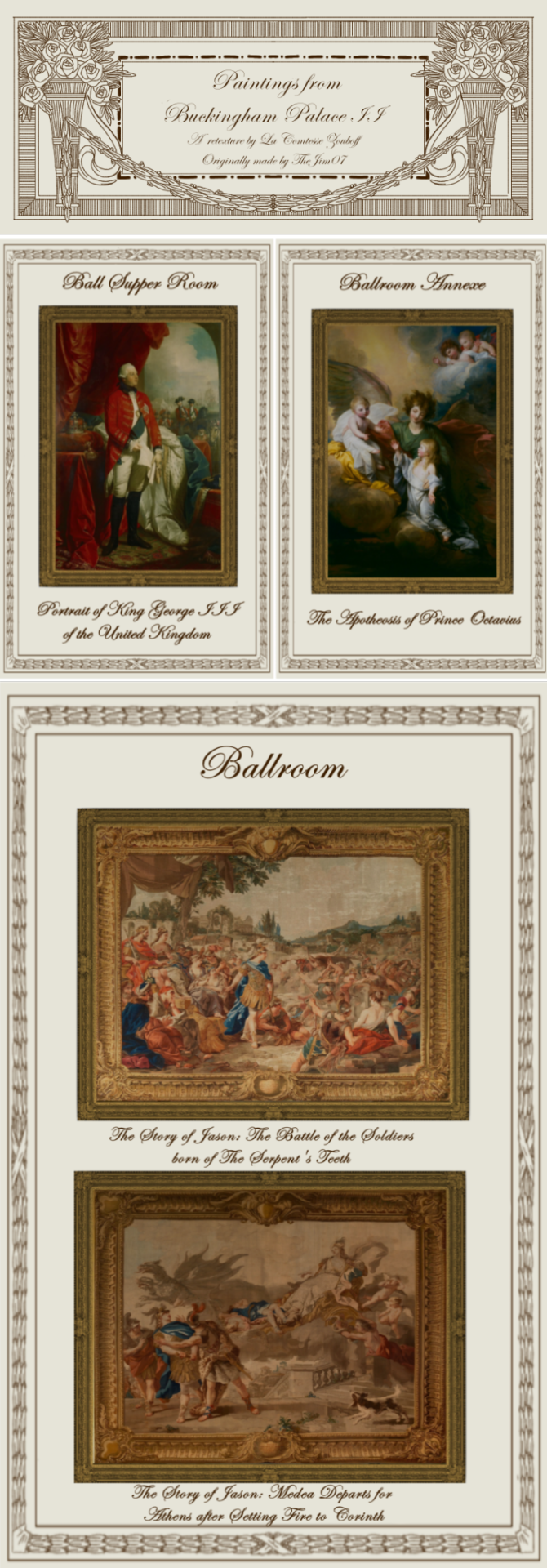
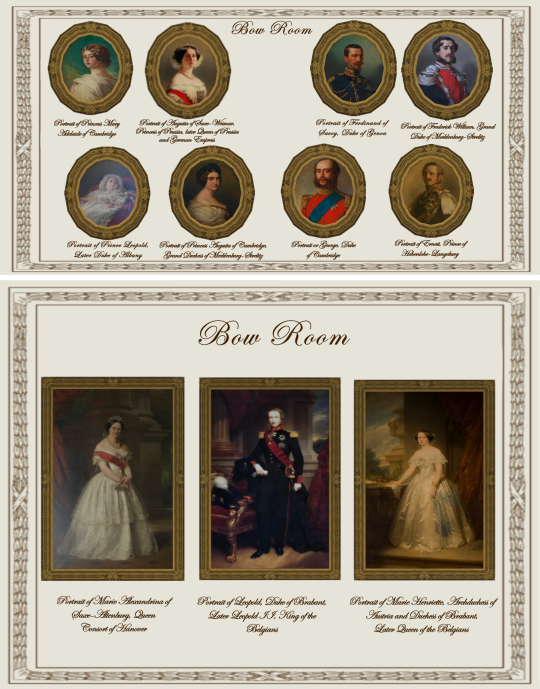
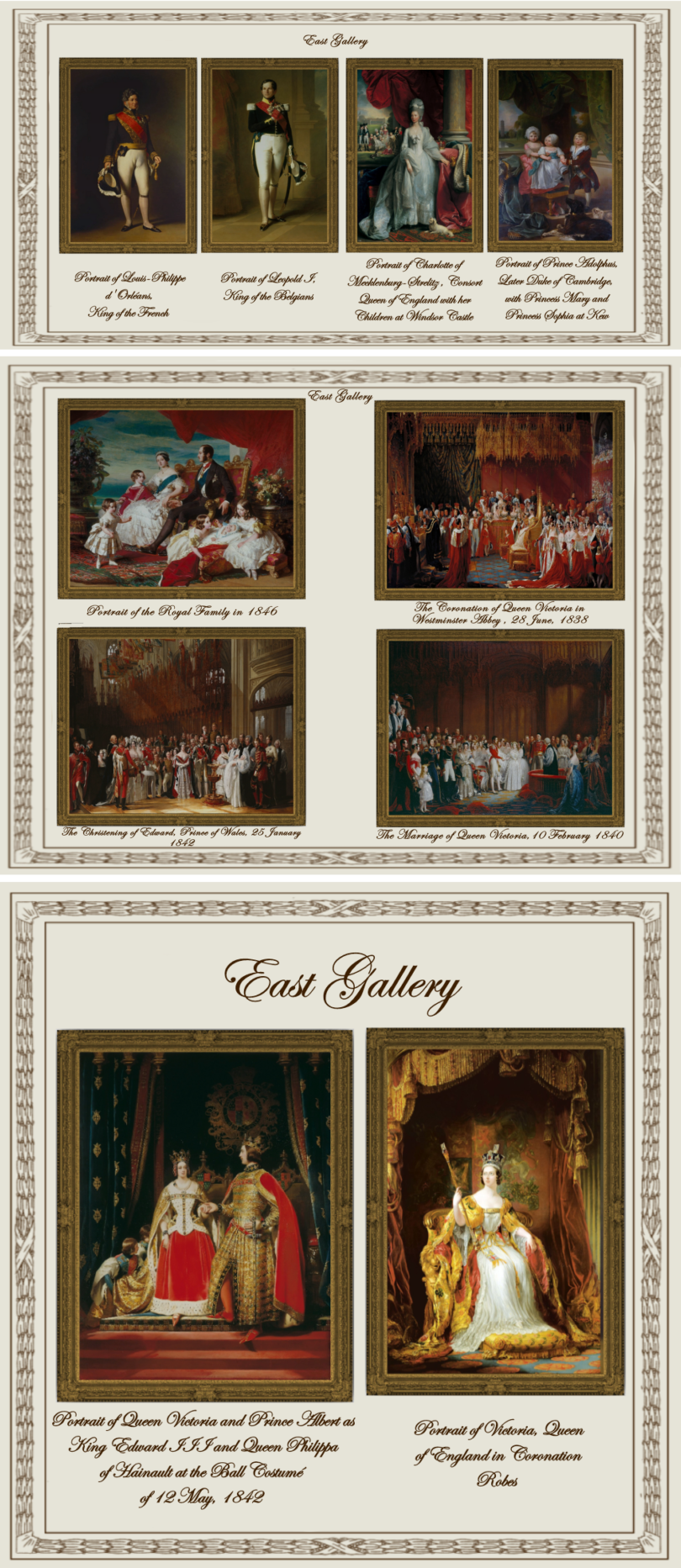
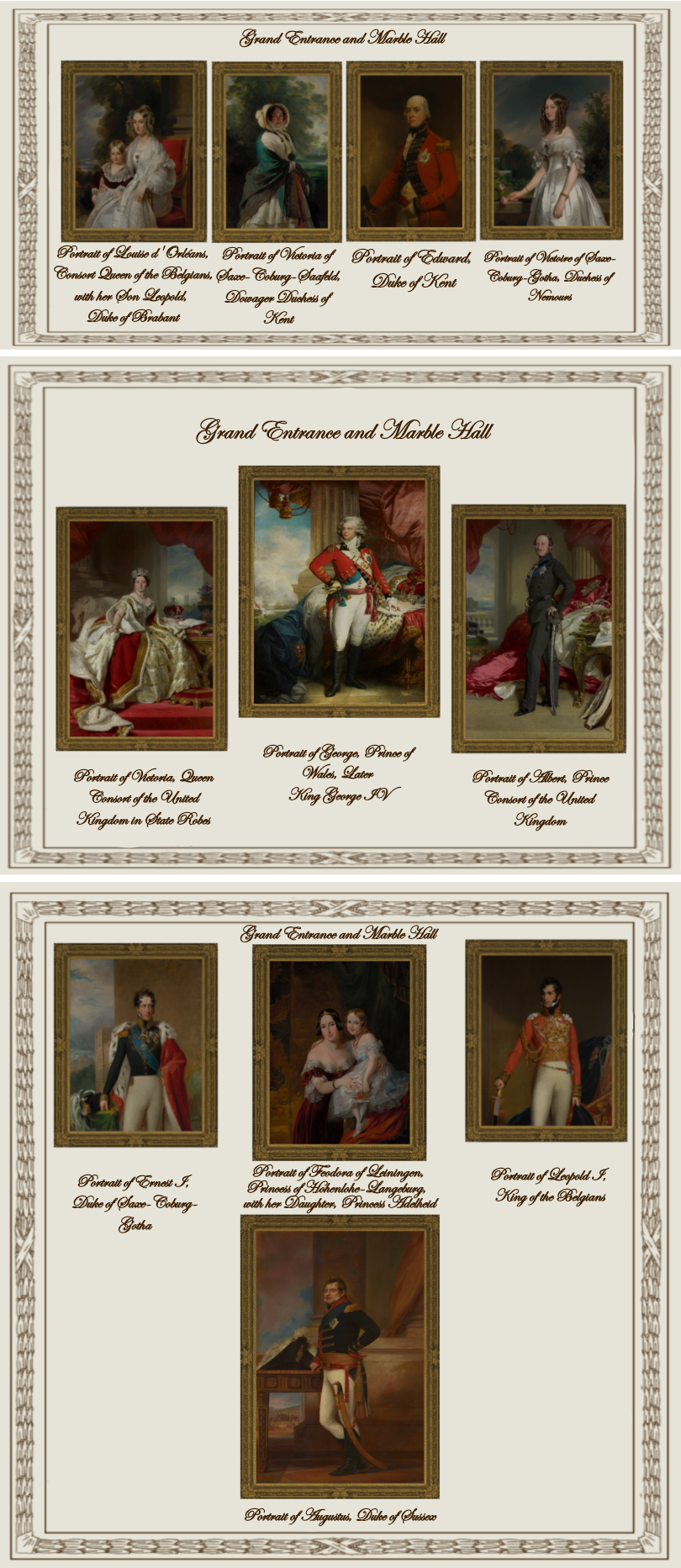

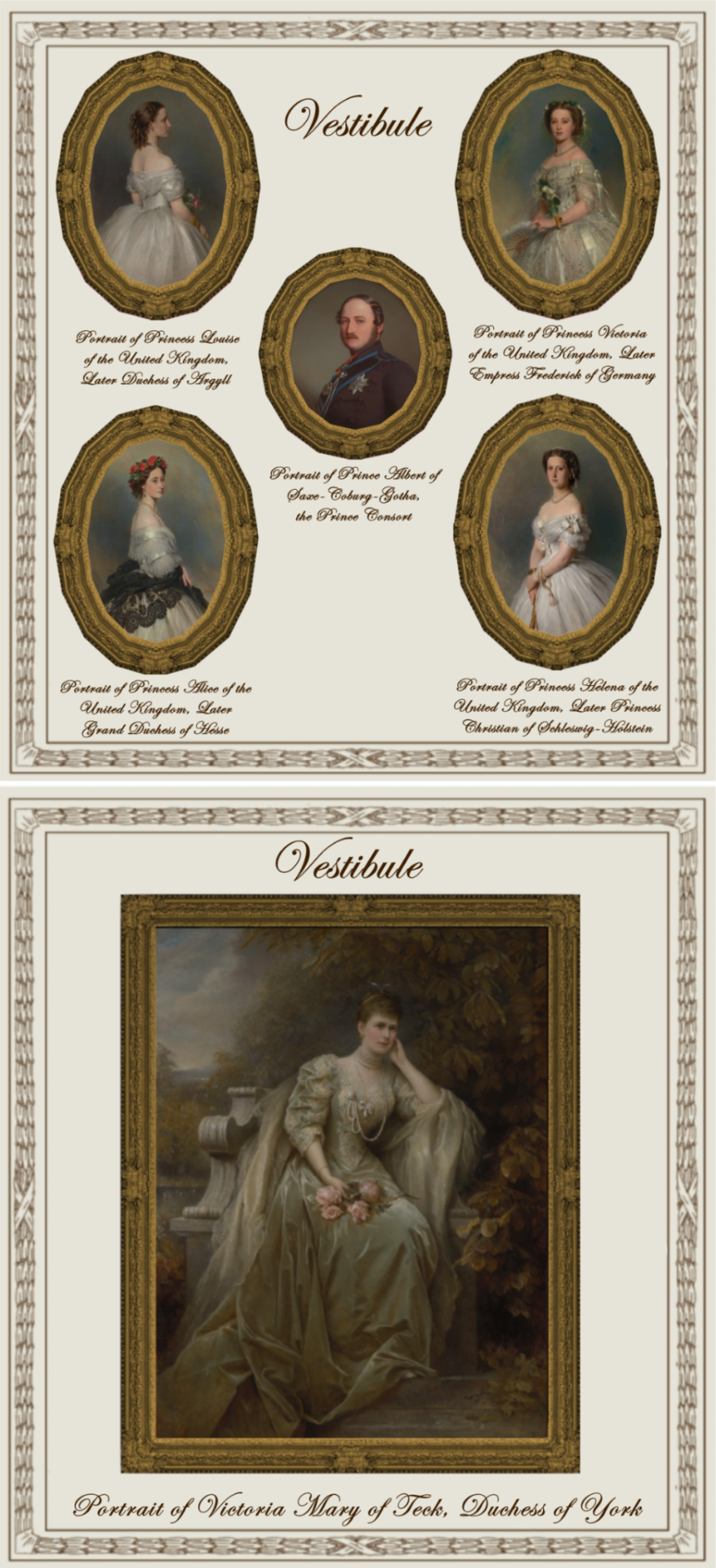
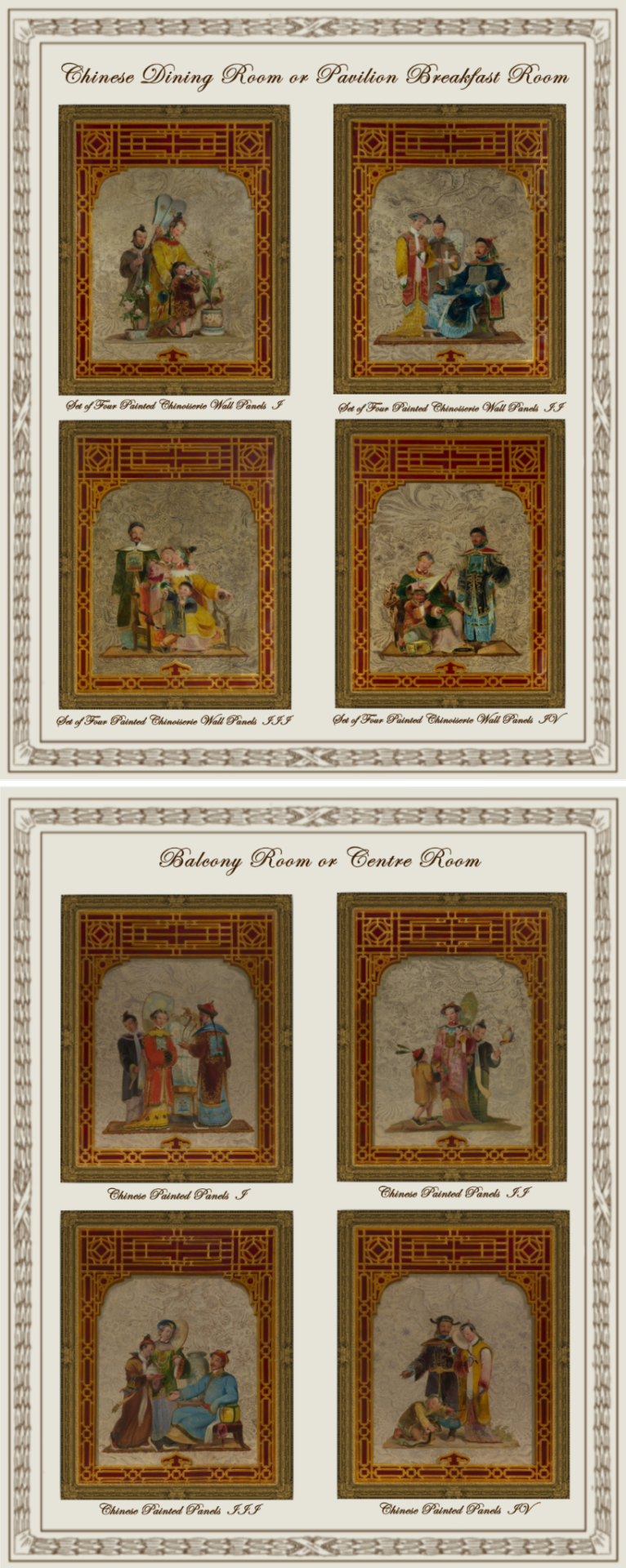

Paintings from Buckingham Palace: part II
A retexture by La Comtesse Zouboff — Original Mesh by @thejim07
Spread among 13 occupied and historic royal residences in the United Kingdom, the collection is owned by King Charles III and overseen by the Royal Collection Trust. The British monarch owns some of the collection in right of the Crown and some as a private individual. It is made up of over one million objects, including 7,000 paintings, over 150,000 works on paper, this including 30,000 watercolours and drawings, and about 450,000 photographs, as well as around 700,000 works of art, including tapestries, furniture, ceramics, textiles, carriages, weapons, armour, jewellery, clocks, musical instruments, tableware, plants, manuscripts, books, and sculptures.
Some of the buildings which house the collection, such as Hampton Court Palace, are open to the public and not lived in by the Royal Family, whilst others, such as Windsor Castle, Kensington Palace and the most remarkable of them, Buckingham Palace are both residences and open to the public.
About 3,000 objects are on loan to museums throughout the world, and many others are lent on a temporary basis to exhibitions.
-------------------------------------------------------
The second part includes paintings displayed in the Ball Supper Room, the Ballroom, the Ballroom Annexe, the Bow Room, the East Gallery, the Grand Entrance and Marble Hall, the Minister's Landing & Staircase, the Vestibule, the Chinese Dining Room and the Balcony Room.
This set contains 57 paintings and tapestries with the original frame swatches, fully recolourable. They are:
Ball Supper Room (BSR):
Portrait of King George III of the United Kingdom (Benjamin West)
Ballroom (BR):
The Story of Jason: The Battle of the Soldiers born of The Serpent's Teeth (the Gobelins)
The Story of Jason: Medea Departs for Athens after Setting Fire to Corinth (the Gobelins)
Ballroom Annexe (BAX):
The Apotheosis of Prince Octavius (Benjamin West)
Bow Room (BWR):
Portrait of Princess Mary Adelaide of Cambridge (William Corden the Younger)
Portrait of Princess Augusta of Cambridge, Grand Duchess of Mecklenburg-Strelitz (Alexander Melville)
Portrait or George, Duke of Cambridge (William Corden the Younger)
Portrait of Frederick William, Grand Duke of Mecklenburg-Strelitz (Franz Xaver Winterhalter)
Portrait of Augusta of Saxe-Weimar, Princess of Prussia, later Queen of Prussia and German Empress (Franz Xaver Winterhalter)
Portrait of Prince Leopold, Later Duke of Albany (Franz Xaver Winterhalter)
Portrait of Ernest, Prince of Hohenlohe-Langeburg (Franz Xaver Winterhalter)
Portrait of Ferdinand of Savoy, Duke of Genoa (Eliseo Sala)
Portrait of Marie Alexandrina of Saxe-Altenburg, Queen Consort of Hanover (Carl Ferdinand Sohn)
Portrait of Leopold, Duke of Brabant, Later Leopold II, King of the Belgians (Nicaise de Keyser)
Portrait of Marie Henriette, Archduchess of Austria and Duchess of Brabant, Later Queen of the Belgians (Nicaise de Keyser)
East Gallery (EG):
Portrait of Leopold I, King of the Belgians (Franz Xaver Winterhalter)
Portrait of Victoria, Queen of England in Coronation Robes (Sir George Hayter)
Portrait of Louis-Philippe d'Orléans, King of the French (Franz Xaver Winterhalter)
Portrait of Charlotte of Mecklenburg-Strelitz, Consort Queen of England with her Children at Windsor Castle (Benjamin West)
Portrait of Prince Adolphus, later Duke of Cambridge, With Princess Mary and Princess Sophia at Kew (Benjamin West)
The Coronation of Queen Victoria in Westminster Abbey, 28 June, 1838. (Sir George Hayter)
The Christening of Edward, Prince of Wales 25 January, 1842 (Sir George Hayter)
The Marriage of Queen Victoria, 10 February, 1840 (Sir George Hayter)
Portrait of the Royal Family in 1846 (Franz Xaver Winterhalter)
Portrait of Queen Victoria and Prince Albert as King Edward III and Queen Philippa of Hainault at the Ball Costumé of 12 May, 1842 (Sir Edwin Landseer)
Grand Entrance and Marble Hall (GEMH):
Portrait of Edward, Duke of Kent (John Hoppner)
Portrait of Ernest I, Duke of Saxe-Coburg-Gotha (George Dawe)
Portrait of Victoria of Saxe-Coburg-Saafeld, Dowager Duchess of Kent (Franz Xaver Winterhalter)
Portrait of Albert, Prince Consort of the United Kingdom (Franz Xaver Winterhalter)
Portrait of Victoria, Queen Consort of the United Kingdom in State Robes (Franz Xaver Winterhalter)
Portrait of Louise d'Orléans, Consort Queen of the Belgians, with her Son Leopold, Duke of Brabant (Franz Xaver Winterhalter)
Portrait of Feodora of Leiningen, Princess of Hohenlohe-Langeburg, with her Daughter, Princess Adelheid (Sir George Hayter)
Portrait of George, Prince of Wales, Later King George IV (Mather Byles Brown)
Portrait of Victoire of Saxe-Coburg-Gotha, Duchess of Nemours (Franz Xaver Winterhalter)
Portrait of Augustus, Duke of Sussex (Domenico Pellegrini)
Portrait of Leopold I, King of the Belgians (William Corden the Younger)
Minister's Landing and Staircase (MLS):
Portrait of George, Prince of Wales in Garther Robes (John Hoppner)
The Loves of the Gods: The Rape of Europa (the Gobelins)
The Loves of the Gods: The Rape of Proserpine (The Gobelins)
Vestibule (VL):
Portrait of Prince Albert of Saxe-Coburg-Gotha, the Prince Consort (Unknown Artist from the German School)
Portrait of Princess Alice of the United Kingdom, Later Grand Duchess of Hesse (Franz Xaver Winterhalter)
Portrait of Princess Helena of the United Kingdom, Later Princess Christian of Schleswig-Holstein (Franz Xaver Winterhalter)
Portrait of Princess Louise of the United Kingdom, Later Duchess of Argyll (Franz Xaver Winterhalter)
Portrait of Princess Victoria of the United Kingdom, Later Empress Frederick of Germany (Franz Xaver Winterhalter)
Portrait of Victoria Mary of Teck, Duchess of York (Edward Hughes)
Chinese Dining Room or Pavilion Breakfast Room(CDR):
Set of Four Painted Chinoiserie Wall panels I (Robert Jones)
Set of Four Painted Chinoiserie Wall panels II (Robert Jones)
Set of Four Painted Chinoiserie Wall panels III (Robert Jones)
Set of Four Painted Chinoiserie Wall panels IV (Robert Jones)
Balcony Room or Centre Room (BR):
Chinoiserie Painted Panel I (Robert Jones)
Chinoiserie Painted Panel II (Robert Jones)
Chinoiserie Painted Panel III (Robert Jones)
Chinoiserie Painted Panel IV (Robert Jones)
EXTRAS! (E):
I decided to add the rest of the tapestries from the story of Jason (wich hangs in the Grand Reception Room at Windsor Castle) and (with Jim's permission) added the original mesh for paintings number 2,3,4 & 5 from the Vestibule (seen here and here) wich was never published. These items are:
The Story of Jason: Jason Pledges his Faith to Medea (the Gobelins)
The Story of Jason: Jason Marries Glauce, Daughter of Creon, King of Thebes (the Gobelins)
The Story of Jason: The Capture of the Golden Fleece (the Gobelins)
The Story of Jason: The Poisoning of Glauce and Creon by Medea's Magic Robe (the Gobelins)
Sea Melodies (Herbert James Draper) (made by TheJim07)
-------------------------------------------------------
Found under decor > paintings for:
500§ (BWR: 1,2,3,4,5,6, & 8 |VL: 1)
570§ (VL: 2,3,4 & 5 |E: 5)
1850§ (GEMH: 1 & 3)
2090§ (GEMH: 2,6,7, 9 & 11)
3560§ (GEMH: 4,5 & 10 |BSR: 1 |EG: 1,2,3,4 & 5 |MLS: 1 |BAX: 1)
3900§ (CDR: 1,2,3 & 4 |BR: 1,2,3 & 4 |EG: 10 |VL: 6 |GEMH: 8)
4470§ (MLS: 2 |E: 1)
6520§ (BR 1 & 2| MLS: 3 |EG: 6,7,8 & 9 |BR: 1 & 2 |E: 2,3 & 4)
Retextured from:
"Saint Mary Magdalene" (BWR: 1,2,3,4,5,6, & 8 |VL: 1) found here.
"Sea Melodies" (VL: 2,3,4 & 5 |E: 5)
"The virgin of the Rosary" (GEMH: 1 & 3) found here.
"Length Portrait of Mrs.D" (GEMH: 4,5 & 10 |BSR: 1 |EG: 1,2,3,4 & 5 |MLS: 1 |BAX: 1) found here
"Portrait of Maria Theresa of Austria and her Son, le Grand Dauphin" (CDR: 1,2,3 & 4 |BR: 1,2,3 & 4 |EG: 10 |VL: 6 |GEMH: 8) found here
"Sacrifice to Jupiter" (MLS: 2 |E: 1) found here
"Vulcan's Forge" (BR 1 & 2| MLS: 3 |EG: 6,7,8 & 9 |BR: 1 & 2 |E: 2,3 & 4) found here
(you can just search for "Buckingham Palace" using the catalog search mod to find the entire set much easier!)
Disclaimer!
Some paintings in the previews look blurry but in the game they're very high definition, it's just because I had to add multiple preview pictures in one picture to be able to upload them all! Also sizes shown in previews are not accurate to the objects' actual sizes in most cases.
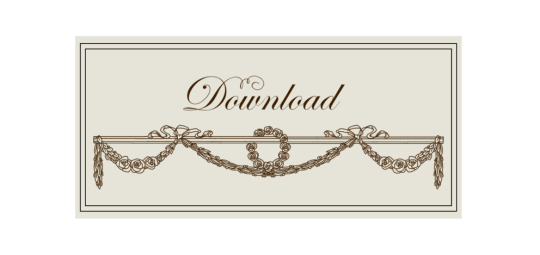
Drive
(Sims3pack | Package)
(Useful tags below)
@joojconverts @ts3history @ts3historicalccfinds @deniisu-sims @katsujiiccfinds @gifappels-stuff
-------------------------------------------------------
#the sims 3#ts3#sims 3#s3cc#sims 3 cc#sims 3 download#sims 3 decor#edwardian#victorian#regency#georgian#buckingham#buckingham palace#wall decor#sims 3 free cc#large pack#this was exhausting
64 notes
·
View notes
Text
The City of Altus
(Lore post! YAY!)

In the Age of the Gods, there were tales of a city -a civilization- of people who had harnessed and controlled a mineral that emitted its own magic. They used these crystals to build machines and vehicles beyond the scope of their peers. It was said, as well, that their discovery and advancement was an affront to the gods. For it, they were banished to the bottom of the sea.
Altus is a coastal island sitting not far East of Pyroxene. Most that live on the mainland tout that the island just 'sprang up' out of the sea about 300 years ago. The island itself consisted of packed spires and temples, along with tiered swaths of land once the ocean fell away. Along with them, the inhabitants of the island had brought impressive technology saved from a bygone era. It was noted that the resource powering their machines was finite; their exile below the waves seemed to make the new neighbors keen to how their influence might affect the world at large.
The leaders of this island, a native royal and scholar supposedly from the Queendom of Roses, still wanted to share their knowledge with the world. So in a bid to open commerce, they began to build. They built boats to fish, homes to house, and opened their arms to the rest of the world. Altus, as it began to call itself, thanked the Queendom of Roses for their outreach and assistance as they gathered materials to make good on their promises.
News of mechanical testing intrigued minds across Twisted Wonderland. Many flocked both to observe the pristine time capsule of an island, with just as many finding themselves rising to the challenge of reverse-engineering this crystalline technology. What Twisted Wonderland's greatest minds found most effective was wind and steam power.
Surrounded by ocean, they had an endless supply of pressure. Salt accumulated from machine filters would go back into the economy or an early form of Reverse Electrodialysis, and steam would continue the water cycle. As for the heat to build said steam: algae biofuel and hiring fire fairies. The fire fairies are compensated appropriately, and the algae is almost never outpaced in its growth vs harvest. And with how blustery the island could get, wind energy was never difficult to come by for more stationary purposes. This is all to say, Steam power and magic made this once ancient technology accessible to the rest of the world.
Modern Day Aspects of Altus:
The outermost ring consists of the train system, delivering people and cargo from one side of the island to the other. The circuit halos the ports, which frame the innermost residential and urban areas.
The largest building is actually the central hilltop that most Airborne Afternoon's festivities take place. It sits protected by the soil, and serves as a community center, city hall, and disaster shelter.
Flying above the urban areas is the one remaining dirigible of Altus' early air fleet: the S.A.S Admiral. It currently serves as the city museum, accepting and letting loose tourists with each lap around the island. You'll hear locals call it 'Old Admiral Boom', namely for the decommissioned front cannons still mounted on it.
The further towards the east end of the island -facing out to open sea- houses a large population of merfolk. Altus hosts one of the few 'Land Camps' offered across the world for mero to integrate towards land living. Schools, in turn, offer language classes in the more common forms of the mero language. (This is how Albert learned Azul had asked the Twins to keep an eye on him)
Whatever forces of nature allow it, Altus finds itself with an almost consistent schedule of their most windy day. That couple of days has so far been predicted with accuracy, so scheduling Airborne Afternoon has not ever been very short notice. Many theorize that its the literal Winds of Change blowing summer away to usher in autumn.
TAGLIST:
@ceruleancattail @squidwen @thecosmicjackalope @vaporvipermedia@writing-heiress
@oya-oya-okay @k-looking-glass-house @thehollowwriter @rainesol @cyn-write
@heartscrypt @honey-milk-depresso @br3adtoasty @jackiecronefield @ruggiethethuggie
@hoboyherewego @achy-boo @oreoskys @oseathepebble @oathofoaks
@tunabesimpin @hamstergal @fumikomiyasaki@valse-a-mille-temps
@hallowed-delights @kimikitti @plutos-hell @thetwstwildcard @atwstedstory
@comingyourlugubriousness @ice-cweam-sod4 @twst-the-night-away @nammanarin @scint1llat3
#Trinket's Rattlin' Bones#twstairborneafternoonevent#twisted wonderland headcanons#twst headcanons#twst lore
25 notes
·
View notes
Text
A Night at the Opera, Part III
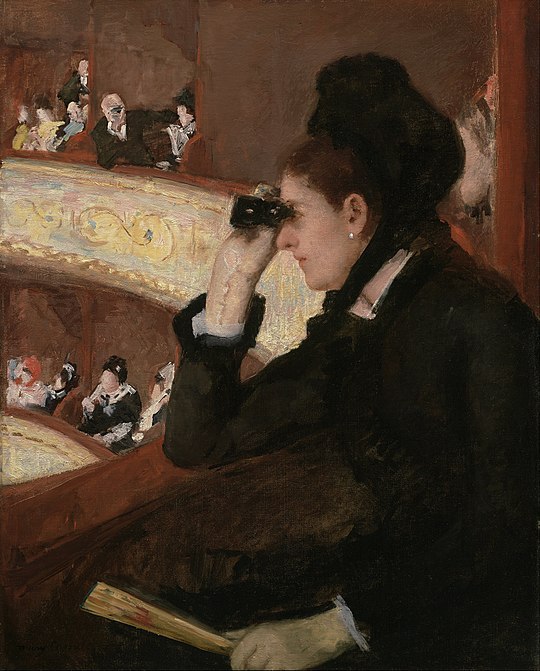
Mary Stevenson Cassat (American, 1824-1936 ) • At the Opera • 1878 • Museum of Fine Arts, Boston
Opera in the Victorian era was as much for the performance, as it was for the social display of socialites and their fine attire. The latter perhaps having been more important. To see and be seen was so much a part of the opera experience, that with the advent of electric lights and the ability to dim the hall during performances, was met with complaints that patrons weren't able to view their surroundings.
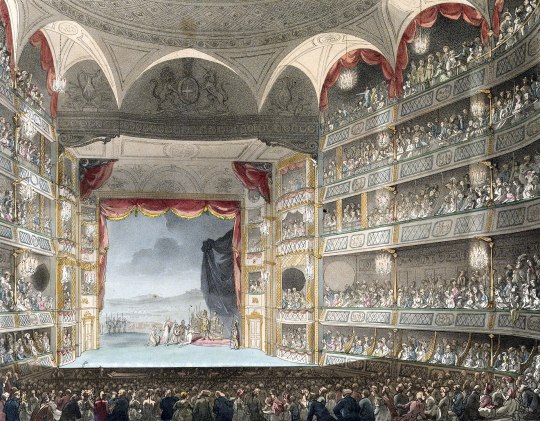
Opera glasses were an integral part of the opera experience. All the better for views of the latest styles and courtship couplings. Opera glasses were being manufactured in beautiful, ornate styles to appeal to fashionable Victorians.

Opera glasses, 19th century. Museum no. S.320-1981. © Victoria and Albert Museum, London
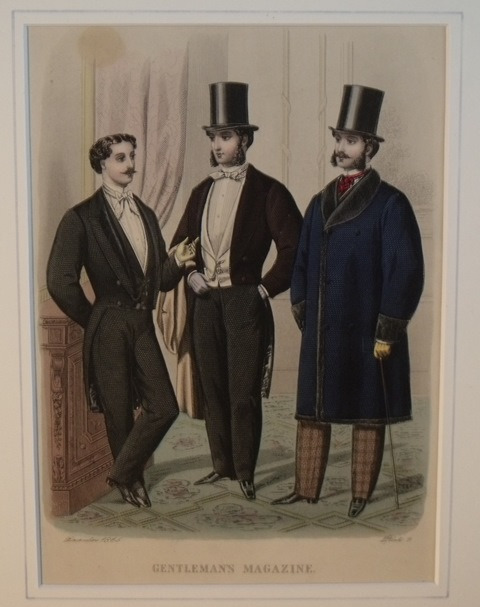
Gentlemen wore top hats and tails to the opera. Just as important as clothing were the rules men had to follow when escorting a lady. For example, during intermission, when many opera-goers left their seats to promenade in the halls, a gentleman was obligated to ask if his lady companion was interested in doing so. If she declined, it was considred unmannerly to leave her seated alone at a performance.


Sources:
Victoria and Albert Museum
Victorian Etiquette - Etiquette at the Theatre, Opera and Concerts
Recollections
Pinterest
#art#painting#art history#fine art#mary cassatt#woman artist#american artist#impressionism#french impressionism#fashion history#art & fashion#victorian society#victorian opera#victorian etiquette#victorian men's clothing#opera accessories#the resplendent outfit art & fashion blog#art blogs on tumblr
48 notes
·
View notes